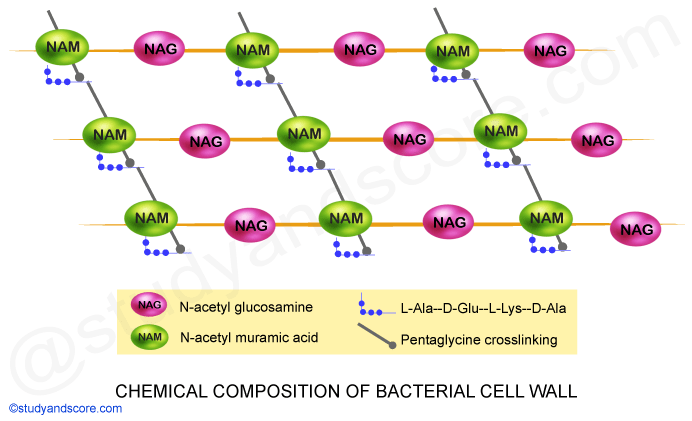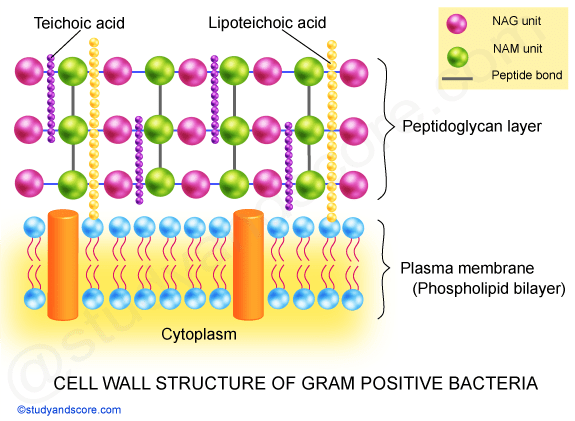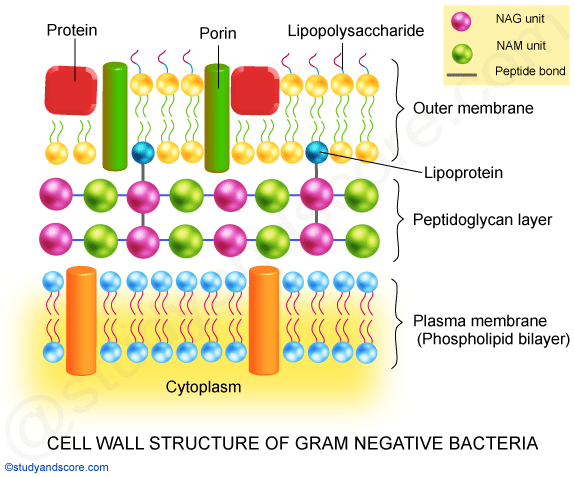A Bacterial cell under an electron microscope reveals many components, some of which are external to the cell wall and some are internal to the cell wall. Some of the structures are confined only to certain species and some other structures act as the characteristic features of certain species. Structures external to the cell wall include flagella, capsules and sheaths. Structures internal to the cell include cytoplasmic membrane and all other cytoplasmic inclusions.
Cell wall is a very rigid structure which provides support and gives shape to the cell. It is about 100-140 nm in thickness. Most of the bacteria live in hypotonic environments and tend to take up water due to the variation in the osmotic pressures between the bacterial cells and the existing environment. Hence, the main function of the cell wall is to prevent the cell from expanding and eventually bursting in the hypotonic environments. Bacterial cell has the ability to retain their original shape when subjected to very high pressures, due to the rigidity of the cell wall.
Cell wall is composed of two polymers, one consisting of saccharide subunits and the other consisting of amino acid subunits. Thus a bacterial cell wall is glycopeptide which is also known as peptidoglycan. The saccharide component of the cell wall has alternating repeating units of two amino sugars related to glucose. One of these two is NAM (N-Acetyl Muramic acid) and the other is NAG (N-Acetyl glucosamine). Both NAG and NAM form the back bone of the cell wall structure.

The alternating units of NAG and NAM are linked together by a glycosidic bond (β-1, 4 linkages). This linkage gives stability and strength to the cell wall. The NAG and NAM chains are cross-linked to one another by tetra peptides that extend off the NAM unit forming a lattice-like structure.
The four amino acids that compose the tetra peptide are: L-alanine, D-glutamine, L-lysine and D-alanine in Gram positive bacteria and actinomycetes. Whereas in Gram negative bacteria and myxobacteria, L-lysine is replaced by diaminopimelic acid (DAP). The inclusion of both L and D amino acids in the structure provides protection from digesting effect of proteases.
In 1884, a scientist named Gram tried to stain the bacterial cells with crystal violet and iodine solution. On washing them with acetone, few bacteria became purple where as others remained colorless. When these bacteria were counter stained with safranin it was observed that some of the bacteria retained purple color and others take up pink color. The bacteria which take purple color are called gram positive bacteria and those which take up pink color are gram negative bacteria.
The bacterial cell wall is not only a protective layer but serves an important purpose of distinguishing bacteria into two major groups namely gram-negative and gram-positive. The walls of gram-positive bacteria have simpler chemical structures compared to gram-negative bacteria.
Gram-positive cell wall is thick measuring about 15-80 nm and more homogenous compared to gram-negative cell wall. This cell wall consists of large amount of peptidoglycan arranged in several layers. Peptidoglycan in gram-positive cell wall constitutes about 40-80% of the dry weight.

Gram positive cell wall consists of teichoic acid and teichuronic acid. Along with these acids, gram positive cell wall also consists of neutral sugars and acidic sugars which occur as subunits of polysaccharides.
Teichoic acids: Teichoic acids are polymers of polyribitol phosphate and polyglycerol phosphate containing ribitol and glycerol. These polymers may have sugar or amino acid substitutes either as side chains or within the chains. Teichoic acids can be of two types namely, wall teichoic acid and lipoteichoic acid. Teichoic acids are connected to the peptidoglycan chain by covalent bond.
Teichuronic acids: Teichuronic acid comprises of the repeated units of sugar acids. These are synthesized as substitutes of teichoic acids, when the phosphate supply in the cell is not sufficient.
Gram negative cell wall more complex compared to gram positive cell wall. The amount of peptidoglycan is also considerable less in gram negative cell wall. Not more than two layers of peptidoglycan are present just outside the gram negative cell wall.

Outside the peptidoglycan layer three main components namely lipoprotein layer, outer membrane and lipopolysaccharides are present.
Lipoprotein layer: this layer is mainly composed of special lipoproteins called as Braun’s lipoproteins. These lipoproteins are small and are covalently joined to the underlying peptidoglycan layer. They are embedded in the outer membrane by its hydrophobic end.
Outer membrane: This membrane is a bilayered structure. The inner part resembles the cell membrane in composition while the outer part is distinct. The proteins in the outer membrane include porins and outer membrane proteins.
Lipopolysaccharides: Lipopolysaccharides are complex molecules. They are adhesive in nature and help the gram negative bacteria to adhere. This layer consists of three main components namely, lipid A, Core oligosaccharide and O polysaccharide.
| Character | Gram +ve cell wall | Gram-ve cell wall |
|---|---|---|
| Thickness of cell wall | 15-80nm | 2nm |
| Lipid content | 2-5% | 15-20% |
| Teichoic acid | Present | Absent |
| Amino acid variety | Few | Several |
| Aromatic amino acids | Absent | Present |
| Sulfur containing amino acids | Absent | Present |
| Treatment with lysozyme | Protoplast | Spheroplast |

- Share with your friends! -
Login to post your comment here...
- or with social Account -